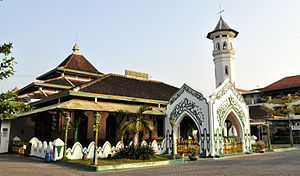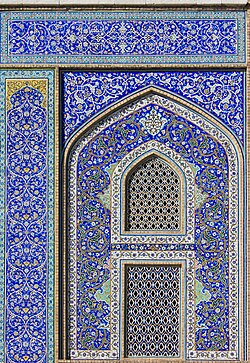Tajug
From Wikipedia, the free encyclopedia

Tajug seen here on the roof of Wustho Mangkunegaran Mosque, Surakarta.
Tajug is a pyramidal or pyramid square (i.e. an equilateral square base with a peak) ornament which is usually used for sacred buildings in Southeast Asia including Indonesia, such as mosque or cupola graveyard. It is considered derived from Indian and Chinese architecture, which has history since pre-Islamic era, although there's also an element of an influence from Indian mosques.[1] The term tajug is also used to refer to mosques or surau (Islamic assembly building) in some regions of Indonesia.
See also[]
 Indonesia portal
Indonesia portal
- Indonesian mosques
References[]
- ^ Architecturalized Asia: Mapping a Continent through History
Islam in Indonesia | |||||||
|---|---|---|---|---|---|---|---|
| Branches |
| ||||||
| Major figures |
| ||||||
| Organizations |
| ||||||
| History |
| ||||||
| Culture |
| ||||||
| Education |
| ||||||
| Politics |
| ||||||
| By region |
| ||||||
| |||||||
Architecture of Indonesia | |||||||||||||||
|---|---|---|---|---|---|---|---|---|---|---|---|---|---|---|---|
| Vernacular architecture |
| ||||||||||||||
| Hindu-Buddhism in Indonesia |
| ||||||||||||||
| Islam in Indonesia | |||||||||||||||
| Dutch colonial |
| ||||||||||||||
| Post-colonial & contemporary |
| ||||||||||||||
Category | |||||||||||||||
Islamic architecture | ||||||||||||||||||||
|---|---|---|---|---|---|---|---|---|---|---|---|---|---|---|---|---|---|---|---|---|
| Styles |
| |||||||||||||||||||
| Elements |
| |||||||||||||||||||
| Types |
| |||||||||||||||||||
| Resources |
| |||||||||||||||||||
| Influences |
| |||||||||||||||||||
| Category pages |
| |||||||||||||||||||
Part of Islamic arts | ||||||||||||||||||||
This architectural element–related article is a stub. You can help Wikipedia by . |
- v
- t
Retrieved from ""
Categories:
- Islamic architectural elements
- Islamic architecture
- Architecture of Indonesia
- Javanese architecture
- Architectural elements
- Ornaments (architecture)
- Architectural element stubs
Hidden categories:
- All stub articles
